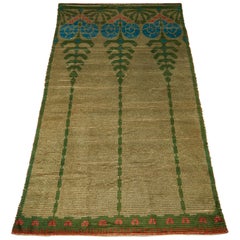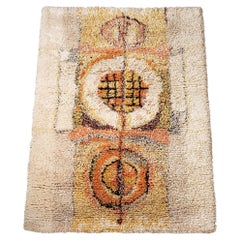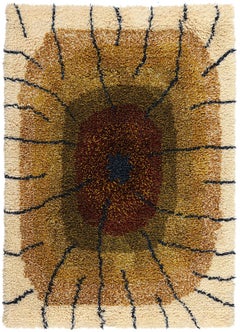Emma Salzman Rugs and Carpets
to
Width
to
Length
to
1
1
1
1
1
1
1
1
1
1
1
1
1
1
8,869
3,910
1,428
1,215
Creator: Emma Salzman
Rug Designed by Emma Salzman, Finland, Early 1900s
By Emma Salzman
Located in Stockholm, SE
Rug designed by Emma Salzman,
Finland, early 1900's.
Rya technique. Handwoven wool.
Measurements:
H: 349 cm/ 11' 5 7/16"
W. 185 cm/ 6 26/32"
Category
Early 1900s Finnish Scandinavian Modern Antique Emma Salzman Rugs and Carpets
Materials
Wool
Related Items
Scandinavian Modern "Kehrä" Rya Wool Rug, Designed by Leena-Kaisa Halme, Finland
Located in Karis, Nyland
This classic Finnish rya rug or wall hanging was designed by Leena-Kaisa Halme. Model is called "Kehrä" (Spindle). It features pretty and earthy tones...
Category
1960s Finnish Scandinavian Modern Vintage Emma Salzman Rugs and Carpets
Materials
Wool
$1,525 Sale Price
20% Off
W 43.31 in L 61.82 in
Vintage Finnish Pyörylät Ryijy Rug by Laila Seppä
By Laila Seppä
Located in Dallas, TX
78828 Laila Seppa Vintage Finnish Ryijy Rug, 03'10 x 05'04. Laila Seppä is a prominent Finnish textile designer celebrated for her innovative and artistic approach to textile arts. H...
Category
Late 20th Century Finnish Scandinavian Modern Emma Salzman Rugs and Carpets
Materials
Wool
1900s Antique Uzbek Khotan Samarkand Rug-5'8'' X 4'1''
Located in Los Angeles, US
Up for sale is a 1900s Antique Uzbek Khotan Samarkand Rug 5'8'' x 4'1'', tribal and traditional, wool on cotton
Category
Early 1900s Uzbek Tribal Antique Emma Salzman Rugs and Carpets
Materials
Wool, Cotton
Alestalon Mattokutomo Large Finnish Flat-Weave Rug, Finland, 1950s
By Alestalon Mattokutomo
Located in Los Angeles, CA
Alestalon Mattokutomo Large Finnish flat-weave rug, Finland, 1950s. Size: 107" x 74".
Handmade by Alestalon Mottokutom, this exquisite flat-weave rug has a very interesting comple...
Category
Mid-20th Century Finnish Scandinavian Modern Emma Salzman Rugs and Carpets
Materials
Wool
$3,740 Sale Price
44% Off
W 74 in L 107 in
1900s Oriental Animal Print Khotan Samarkand Rug
Located in Los Angeles, US
Antique Samarkand Rugs: The desert oasis of Khotan was an important stop on the Silk Road. The people of Khotan were expert carpet weavers who produced high quality antique rugs and ...
Category
19th Century Tribal Antique Emma Salzman Rugs and Carpets
Materials
Wool, Cotton
1900s Antique Khotan Samarkand Rug
Located in Los Angeles, US
Antique Samarkand Rugs: The desert oasis of Khotan was an important stop on the Silk Road. The people of Khotan were expert carpet weavers who produced high quality antique rugs and ...
Category
Early 1900s Other Antique Emma Salzman Rugs and Carpets
Materials
Wool, Cotton
1900s Antique Uzbek Khotan Samarkand Rug-8'10'' X 5'6''
Located in Los Angeles, US
Antique Uzbek Khotan Samarkand Rug 8'10'' X 5'6'', tribal and traditional, antique and vintage, wool on cotton foundation
Category
Early 1900s Uzbek Tribal Antique Emma Salzman Rugs and Carpets
Materials
Wool, Cotton
Finnish Flat Weave Rug, 1930s
Located in Helsinki, Uusimaa
Finnish flat weave rug, 1930s. Wool. Double-sided. Good vintage condition, patina consistent with age and use.
Category
1930s Finnish Scandinavian Modern Vintage Emma Salzman Rugs and Carpets
Materials
Wool
1900s Authentic Tribal Floral Khotan Rug
Located in Los Angeles, US
Antique Samarkand Rugs: The desert oasis of Khotan was an important stop on the Silk Road. The people of Khotan were expert carpet weavers who produced high quality antique rugs and ...
Category
19th Century Tribal Antique Emma Salzman Rugs and Carpets
Materials
Wool, Cotton
Finnish Flat Weave Rug
Located in New York, NY
Finnish Flat Weave Rug
Finland, circa 1930s
Handwoven
Category
Mid-20th Century Finnish Scandinavian Modern Emma Salzman Rugs and Carpets
Materials
Wool
1900s Antique French Needlepoint Rug
Located in Los Angeles, US
Needlepoint rugs were created using the traditional needlework weaving technique that is used to make everyday items from furniture to carpets and artwork. However, it has a fascinating history both as a hobby and as an industry. When many people think of carpets, they think of pile carpets or flat weave kilims, but needlepoint has also been used to create beautiful carpets. These carpets are durable and an important part of carpet history.
Archaeologists and scholars consider the roots of needlepoint to have been around 1500 BC. They consider the first needlepoint to include the fine diagonal stitches that were used to sew tents together by the ancient Egyptians. The art eventually evolved into tapestry weaving. However, a tapestry weaving differs significantly from needlepoint in that it uses a loom and vertical warp.
Tapestry weaving is closer to the weaving of kilims and pile rugs than canvas work. However, some still include tapestry weaving in the category of needlepoint because of the fine work that appeared during the late Renaissance. It can have a similar appearance to the untrained eye. Technically, tapestry weaving and needlepoint are not the same, and they do not use the same technique.
The first actual needlepoint rugs and needle-points began to appear in the late Renaissance. Needlepoint is worked by creating stitches on a stiff canvas. The canvas is typically made from jute or linen and is quite durable. Pieces from the Renaissance were used to cover footstools, chairs, pillows, bed headboards, and other furnishings. They were also used as table coverings and wall coverings. You could also find them on many small items such as purses, shoes, and various adornments for clothing.
During the Renaissance, the craft reached a high level of skill, and the designs became incredibly detailed and realistic. They mimicked many of the subjects and styles of famous paintings of the time. They created florals, still life designs, scenes, and geometric tiled pieces. Some of them mimicked the designs found in Persian Carpets.
Needlepoint reached its peak popularity in the 19th century when it was considered a proper occupation for a lady. Needlepoint and embroidery held a similar place in societal status at the time. During this time, the work became finer, with some of the canvas reaching a high level of detail. The level of detail is determined by counting the number of mesh in an inch. During this time petit point by French needlewomen could have a mesh count as high as 45 mesh. This allowed women to create highly intricate designs with incredible levels of detail.
It is possible to find many antique pieces of needlepoint besides rugs. Needlepoint rugs were popular in France and Spain, where the technique was adapted to create highly intricate designs that mimicked the designs in architecture and fashion. They were popular because they were durable, and it could be fashioned into a variety of items. The canvases themselves were durable, and the wool that they used was also strong, which means that many of the pieces were able to withstand daily use. We have many artifacts that have survived from this time period.
Needlepoint rugs are important collectibles because they are different from the pile rugs and kilims that are typically found on the market. Needlepoint carpets are special because they take many hours to create, especially larger works. Needlepoint pieces of any type became popular throughout Europe during the 19th century. It is still a popular hobby today, but perhaps one of the most interesting stories is that of the Portuguese needlewomen of Arraiolos.
The story of these women and their beautiful carpets begins in 1492. Needlepoint was a popular occupation in Spain, which had a large population of Moors and Jews. They were an integral part of Spanish culture. However, in 1492, Queen Isabella of Spain issued a proclamation that gave these ethnic groups the order to pack their bags and board ships headed...
Category
Early 1900s Other Antique Emma Salzman Rugs and Carpets
Materials
Wool, Cotton
1900s Antique Chinese Small Rug - 7'2'' X 4'5''
Located in Los Angeles, US
Antique Chinese Rugs, as opposed to most of the antique rug productions, were woven almost exclusively for internal consumption. Since they were mostly sheltered from European and We...
Category
Early 1900s Asian Other Antique Emma Salzman Rugs and Carpets
Materials
Wool
Emma Salzman rugs and carpets for sale on 1stDibs.
Emma Salzman rugs and carpets are available for sale on 1stDibs. These distinctive items are frequently made of wool and are designed with extraordinary care. There are many options to choose from in our collection of Emma Salzman rugs and carpets, although brown editions of this piece are particularly popular. Many of the original rugs and carpets by Emma Salzman were created in the Scandinavian Modern style in finland during the early 1900s. If you’re looking for additional options, many customers also consider rugs and carpets by and Greta Skogster-Lehtinen. Prices for Emma Salzman rugs and carpets can differ depending upon size, time period and other attributes — on 1stDibs, these items begin at $11,801 and can go as high as $11,801, while a piece like these, on average, fetch $11,801.


